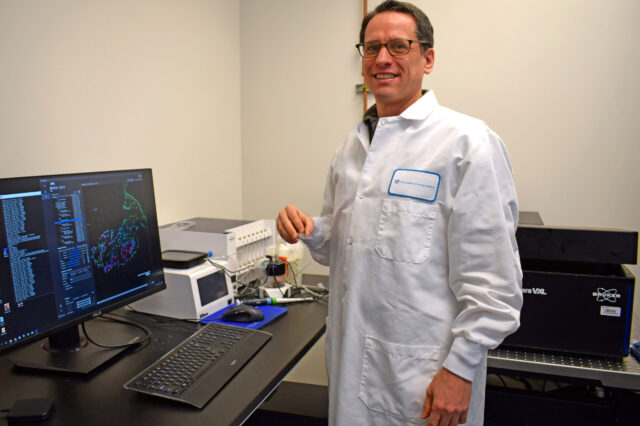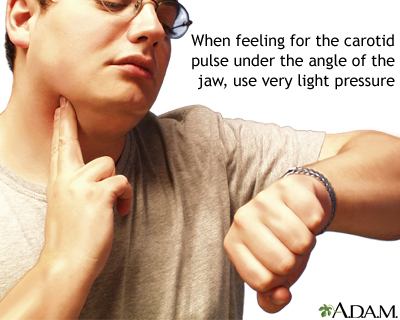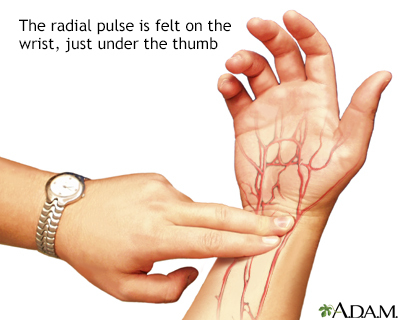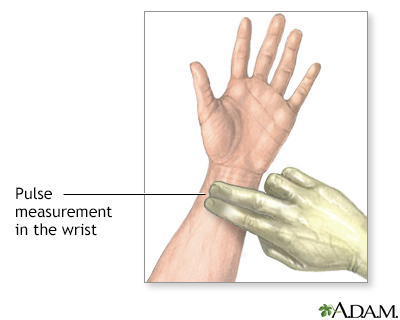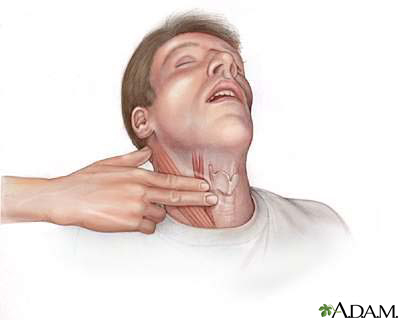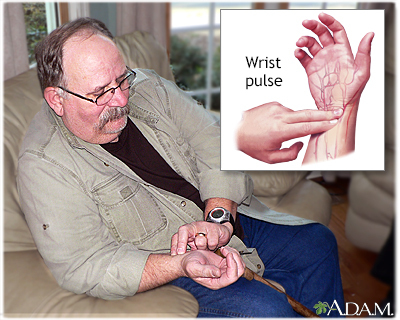Definition
The pulse is the number of heartbeats per minute.
How the Test is Performed
The pulse can be measured at areas where an artery passes close to the skin. These areas include the:
- Back of the knees
- Groin
- Neck
- Temple
- Top or inner side of the foot
- Wrist
To measure the pulse at your wrist, place your index and middle finger over the underside of your opposite wrist, below the base of the thumb. Press with flat fingers until you feel the pulse.
To measure the pulse on the neck, place the index and middle fingers just to the side of the Adam's apple, in the soft, hollow area. Press gently until you locate the pulse.
Note: Sit or lie down before taking the neck pulse. The neck arteries in some people are sensitive to pressure. Fainting or slowing of the heartbeat can result. Also, do not take the pulses on both sides of the neck at the same time. Doing so can slow the flow of blood to the head and lead to fainting.
Once you find the pulse, count the beats for 1 full minute. Or, count the beats for 30 seconds and multiply by 2. This will give the beats per minute.
How to Prepare for the Test
To determine the resting heart rate, you must have been resting for at least 10 minutes. Take the exercise heart rate while you are exercising.
How the Test will Feel
There is a slight pressure from the fingers.
Why the Test is Performed
Measuring the pulse gives important information about your health. Any change from your normal heart rate can indicate a health problem. Fast pulse may signal an infection or dehydration. In emergency situations, the pulse rate can help determine if the person's heart is pumping.
Pulse measurement has other uses as well. During or immediately after exercise, the pulse rate gives information about your fitness level and health.
What Abnormal Results Mean
Resting heart rates that are continually high (tachycardia) may mean a problem. Talk to your health care provider about this. Also discuss resting heart rates that are below the normal values (bradycardia).
A pulse that is very firm (bounding pulse) and that lasts for more than a few minutes should be checked by your provider as well. An irregular pulse can also indicate a problem.
A pulse that is hard to locate may mean blockages in the artery. These blockages are common in people with diabetes or hardening of the artery from high cholesterol. Your provider may order a test known as a Doppler study to check the blockages.
References
Bernstein D. History and physical examination in cardiac evaluation. In: Kliegman RM, St Geme JW, Blum NJ, Shah SS, Tasker RC, Wilson KM, eds. Nelson Textbook of Pediatrics. 21st ed. Philadelphia, PA: Elsevier; 2020:chap 449.
Schriger DL. Approach to the patient with abnormal vital signs. In: Goldman L, Schafer AI, eds. Goldman-Cecil Medicine. 26th ed. Philadelphia, PA: Elsevier; 2020:chap 7.
